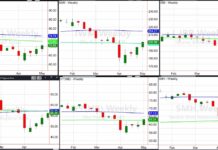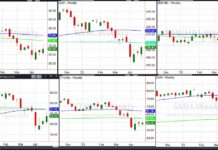 By Greg Naylor May was an eventful month in terms of economic news, with some Fed officials starting to murmur about reducing stimulus. Bond prices reacted negatively in May, while the stock market proved more resilient and continued its year-to-date climb. Here is a re-cap of May, by the numbers:
By Greg Naylor May was an eventful month in terms of economic news, with some Fed officials starting to murmur about reducing stimulus. Bond prices reacted negatively in May, while the stock market proved more resilient and continued its year-to-date climb. Here is a re-cap of May, by the numbers:
U.S. Stock Market & Bond Market
The U.S. stock market continued its strong start to the year. International stocks continue to be volatile, as good news is tempered by a strengthening dollar and falling commodity prices.
| S&P 500 Total Return | MSCI EAFE | BarclaysAggregateBond | Unadjusted CPI | |
| May | 2.34% | -2.93% | -1.78% | -0.10% |
| April | 1.93% | 4.72% | 1.01% | 0.26% |
| YTD 2013 | 15.37% | 6.11% | -0.91% | 1.00% |
Commodities & Currencies
NYMEX crude fell 1.56% in May. Gold fell again, by 5.46% to a close of $1,393 per ounce. Silver and most other commodities also saw price declines. The dollar index rose 1.63% in May.
Economy
The Labor Department reported that the unemployment rate continued to fall, to 7.5% in April from7.6% in March. The Institute for Supply Management reported that the manufacturing PMI in April fell yet again, to 49.0, a number which indicates contraction in the U.S. manufacturing sector.
The National Association of Realtors (NAR) reported that the annual rate of existing-home sales in April increased by 0.6% from April 2012. National median prices rose from the prior year by 11.0% to $192,800. Foreclosures and short-sales, as a percentage of overall sales, declined to 18% in April.
Summary
Even as the stock market hit new highs, the next round of bad economic news is starting to show its head. Despite tremendous stimulus from the Federal Reserve, commodity prices are starting to fall, manufacturing is threatening to contract again, and unemployment remains stubbornly high. Some studies suggest that, contrary to textbook economics, economies with aging populations are more likely to face deflation than inflation. This adds to the concern that the U.S. could be facing a multi-year deflationary cycle on par with Japan.
This material was prepared by Greg Naylor, and does not necessarily represent the views of Woodbury Financial or its affiliates. This information should not be construed as investment, tax or legal advice and may not be relied upon for the purpose of avoiding any Federal tax liability. This is not a solicitation or recommendation to purchase or sell any investment or insurance product or service, and should not be relied upon as such. The S&P500, MSCI EAFE and Barclays Aggregate Bond Index are indexes. It is not possible to invest directly in an index. Investing involves risks and investors may incur a profit or a loss. Past performance is not an indication of future results.
Data Sources:
- www.standardandpoors.com – S&P 500 information
- www.msci.com – MSCI EAFE information
- www.barcap.com – Barclays Aggregate Bond information
- www.bloomberg.com – U.S. Dollar & commodities performance
- www.realtor.org – Housing market data
- www.bea.gov – GDP numbers
- www.bls.gov – CPI and unemployment numbers
- www.commerce.gov – Consumer spending data
- www.napm.org – PMI numbers
- www.bigcharts.com – NYMEX crude prices, gold and other commodities
- https://www.imes.boj.or.jp/research/papers/english/12-E-03.pdf – Deflation and aging study
About Greg Naylor: Greg is a partner and co-founder of Fiat Wealth Management, an independent financial advisory firm in Long Lake, Minnesota. He has been investing for over 7 years and enjoys sports, reading, singing, and spending time with family. Greg is a 2004 graduate of the University of Minnesota and lives in South Minneapolis with his wife Kat.
Twitter: @seeitmarket Facebook: See It Market








